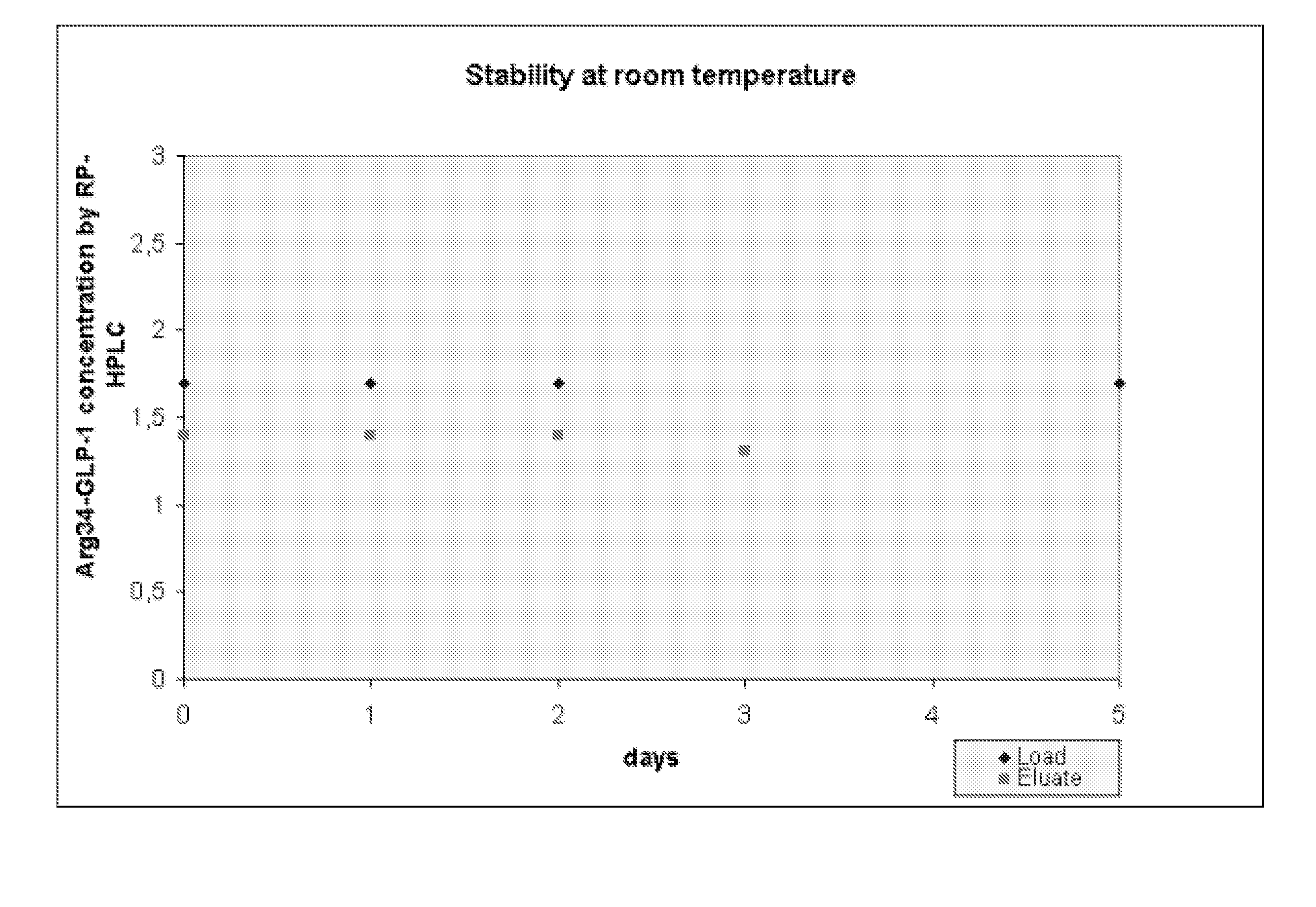Use of tris(hydroxymethyl) aminomethane for the stabilization of peptides, polypeptides and proteins
a technology of hydroxymethyl aminomethane and peptide, which is applied in the direction of peptides, peptide/protein ingredients, peptide sources, etc., can solve the problems of high clearance rate of native polypeptides, destabilization of peptides, polypeptides and proteins in both formulation solutions and in solution during processing, and difficulty in onset or inciden
- Summary
- Abstract
- Description
- Claims
- Application Information
AI Technical Summary
Benefits of technology
Problems solved by technology
Method used
Image
Examples
example 1
[0035]An aqueous solution of Arg34-GLP-1[7-37] containing approximately 2% by weight ethanol and 10 mM of tris(hydroxymethyl)aminomethane, at pH 9.2 was made at room temperature, pH was adjusted to 3.2. The room temperature stability of the solution was monitored by RP-HPLC.
[0036]The solution was loaded on an ion-exchange column, Source 30S, Amersham Bioscience, at pH 3.23 and after washing the column with an acid buffer containing ethanol and citric acid, the product was eluted with an aqueous solution containing 10 mM Tris at pH 9.2. The room temperature stability of the eluate from the column was monitored by RP-HPLC (Table 1) / (FIG. 1).
[0037]
TABLE 1Arg34-GLP-1[7-37]concentration in loadingArg34-GLP-1[7-37]Daysolutioneluate concentration01.7 mg / ml1.4 mg / ml11.7 mg / ml1.4 mg / ml21.7 mg / ml1.4 mg / ml3Not analyzed1.3 mg / ml4Not analyzedNot analyzed51.7 mg / mlNot analyzed
[0038]Gelation / fibrillation / aggregation was not observed in either of the samples tested.
example 2
[0043]An aqueous solution of Arg34-GLP-1[7-37] containing approximately 2% by weight ethanol and 10 mM of tris(hydroxymethyl)aminomethane, at pH 9.2 was made at room temperature by dissolution of an Arg34-GLP-1[7-37] isoelectric precipitate directly in the solution. Subsequently, pH was adjusted to 3.2.
[0044]A preparative aliquot of the solution was loaded on a large scale ion-exchange column, 20 cm I.D. (internal diameter), Source 30S, Amersham Bioscience, at pH 3.3 and after washing the column with an acid buffer containing ethanol and citric acid to remove impurities, the product was eluted with an aqueous solution containing 10 mM Tris at pH 9.2. The column was regenerated with 1 M NaOH, equilibrated with the acidic wash buffer, and the column was loaded again with loading solution. Eluate from the Source 30S column was automatically pH adjusted with 100 mM tris buffer pH 7.4 to pH 8.0.
[0045]After 60 runs on the Source 30S column no change in pressure was observed, thus no fibri...
example 3
[0046]An aqueous solution of Nε-hexadecanoyl-γ-glutamyl-Lys26-Arg34-GLP-1[7-37] containing approximately 2% by weight ethanol and 10 mM of tris(hydroxymethyl)aminomethane, at pH 9.2 was made at room temperature by dissolution of an Nε-hexadecanoyl-γ-glutamyl-Lys26-Arg34-GLP-1[7-37] isoelectric precipitate directly in the solution.
[0047]A preparative aliquot of the solution was loaded on a large scale ion-exchange column, 45 cm I.D. (internal diameter), Source 30Q, Amersham Bioscience, at pH 9.2 and after washing the column with an buffer containing 20 mM tris and 63% by weight ethanol (pH 7.5) to remove impurities, the product was eluted by a sodium chloride gradient at pH 7.5 in a 20 mM tris buffer containing 63% by weight ethanol. The column was regenerated with 1 M NaOH, equilibrated with the pH 7.5 wash buffer, and the column was loaded again with loading solution. Eluate from the Source 30Q column was automatically diluted with water before it was loaded on another large scale ...
PUM
| Property | Measurement | Unit |
|---|---|---|
| pH | aaaaa | aaaaa |
| pKA | aaaaa | aaaaa |
| pH | aaaaa | aaaaa |
Abstract
Description
Claims
Application Information
 Login to View More
Login to View More - R&D
- Intellectual Property
- Life Sciences
- Materials
- Tech Scout
- Unparalleled Data Quality
- Higher Quality Content
- 60% Fewer Hallucinations
Browse by: Latest US Patents, China's latest patents, Technical Efficacy Thesaurus, Application Domain, Technology Topic, Popular Technical Reports.
© 2025 PatSnap. All rights reserved.Legal|Privacy policy|Modern Slavery Act Transparency Statement|Sitemap|About US| Contact US: help@patsnap.com

